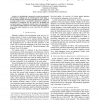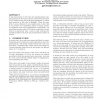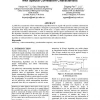13214 search results - page 2 / 2643 » Pseudorandomness for network algorithms |
SOCC
2008
IEEE
14 years 2 months ago
2008
IEEE
— A methodology is proposed to reduce power/ground and substrate coupling noise by randomizing the clock signal. A pseudo-random number generation algorithm is used to produce a ...
ICCS
2001
Springer
14 years 1 months ago
2001
Springer
Parallel computing has been touted as the pinnacle of high performance digital computing by many. However, many problems remain intractable using deterministic algorithms. Randomiz...
COMPGEOM
2000
ACM
14 years 27 days ago
2000
ACM
It has been known for 30 years that pseudorandom number generators in the class of linear congruential generators (LCG) exhibit strong and predictable regularities. A widely used ...
WSCG
2004
13 years 10 months ago
2004
A public-key asymmetric robust watermarking algorithm based on signal with special correlation characteristic is proposed in this paper. This algorithm is designed to permit pubic...
JOC
1998
13 years 8 months ago
1998
We describe a software-e cient encryption algorithm named SEAL 3.0. Computational cost on a modern 32-bit processor is about 4 clock cycles per byte of text. The cipher is a pseudo...



